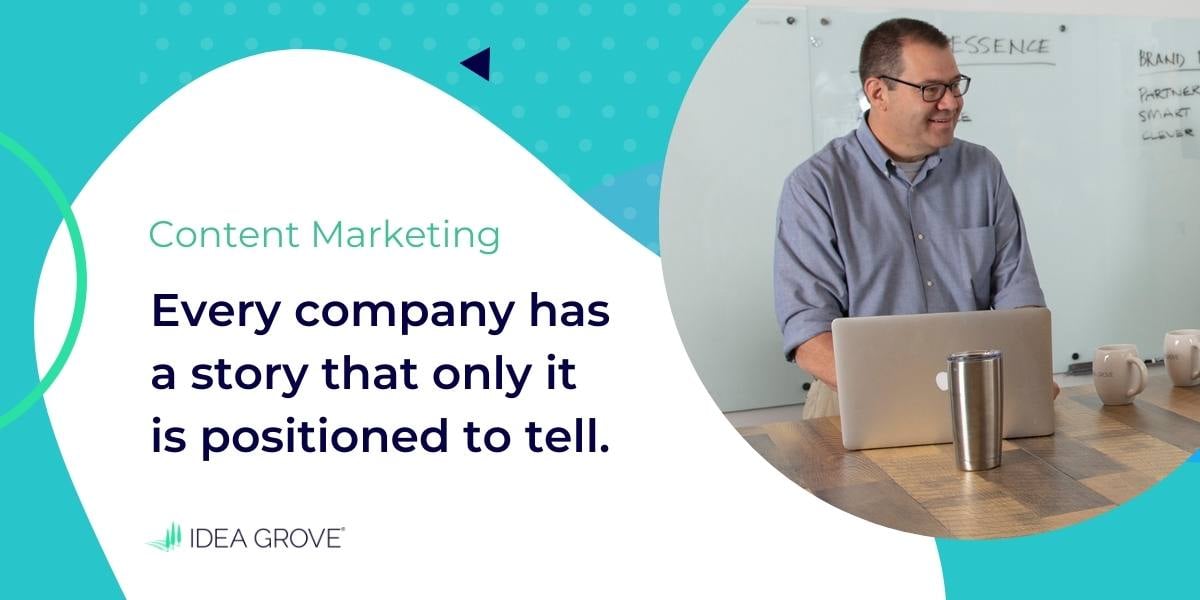You’ve done it: You’ve made the commitment to start a B2B content marketing program. Realizing you lack the people or the time (or both) to tackle the task on your own, you’ve decided to work with a B2B content marketing agency to help you with strategy and develop the content you need.
What should you do now? Talk with them.
What to Discuss

Discuss your marketing goals and how you would like content to help you reach them. Talk about how you see your company, where you think it’s headed, what it needs to do to get there. Don’t forget to include your internal subject-matter experts (SMEs) in the conversation.
Keep this introduction high-level and informative. Give your B2B content marketing agency any existing collateral, strategy documents or other background you think might be helpful.
Be sure to cover questions like:
- What types of content you think will be most effective
- How frequently you would like to produce it
- What kind of access the agency will have to your SMEs
- Who will be involved in getting the content approved
- What tone you want your content to take
- What keywords you wish to focus on for search presence
- What the competition is doing well or poorly with content
- What the unmet content needs are in your target market
This discussion doesn’t have to turn into an all-day, order-lunch meeting. But it should happen. It’ll help the entire process run more smoothly.
Start with Your thought Leaders

We’ve all heard The Company Line. We know we’re being sold something and we know we’re not being told the whole truth—and we resent it.
How do you create marketing content that engages readers and accomplishes your goals? Start by making content that helps rather than sells—and that in the process shows you're smart.
Most successful organizations are built on the experience and expertise of a select group of people. These people should be the owners of your brand's thought leadership. That doesn't mean they have to do the writing; the agency can help with that. But it means they should have their byline on the articles, that their content should be based on their ideas, and that they should review and approve it.
Their industry and product knowledge will give the content credibility. Their contacts might even help distribute it. So:
- Select a handful of people to whom you want to own your thought leadership.
- Help them understand how this will help their personal brands.
- Encourage them to be more active in social media.
- Let them know the agency will be respectful of their time—and make them look good!
- Get them involved in selecting topics for helpful content right away.
This last point is an important one. An executive or SME will always be more helpful in creating content if the topic is something about which they know and have opinions. If someone has worked to become an effective SME, they’ve got opinions—probably quite a few of them.
Thought leadership content is a great top-of-the funnel content for beginning to engage and earn the trust of future customers. And remember: only 5% of the folks who come across your content aren't ready to buy; that makes thought leadership crucial to building a relationship of trust with that other 95%—for when they are ready.
Let Your Customers Tell Your Story

It’s so easy to think of a company as a collection of products or services. But what your audience really wants is for your brand to be more three-dimensional than that: to have a perspective, to have a personality, to have a heart—to have a story. That's what forms the emotional connection that builds a sense of trust with your target market.
Your brand story is best told through the experiences of your customers. Don't focus on how great you are, but on the greatness your customers can achieve with your help.
That means you will need to work with your B2B content marketing agency to identify current and past customers who are willing to be interviewed and appear in your campaign. Since you're making your customer the hero of the narrative, you can make a strong case that they aren't just doing you a favor by telling their story—they are receiving a benefit as well. It's a win-win.
It just make sense to make your customer the hero of your story; after all, that's who you want your prospects to emulate. You are their tool or guide.
As Donald Miller puts it: "Your audience is Luke Skywalker. You get to be Yoda."
Or if not Yoda, perhaps a lightsaber.
As you move your prospects into the funnel with thought leadership and other top-of-the-funnel content, they will want to understand what it's like to use your product or work with your brand. And don't take this personally, but they don't want to hear this from you.
It's human nature: People trust what other people say about you more than what you say about yourself.
That's why case studies, testimonials, customer press releases, customer reviews and other forms of third-party validation are so important as prospects begin to consider you a potential solution to their needs. As your audience gets closer to your product in your content marketing program, the story needs to be told by your users, not by you.
Write With A Purpose

So many content marketing programs get off on the wrong foot. They begin with a statement like, “I think we need a white paper about our new product.”
That's starting with tactics rather than strategy, and from the perspective of your needs rather than those of your audience. If you take this approach with a good content marketing agency, they will push back and advise you to start from your prospect's perspective instead.
What problems do your customers have that you can help them solve? The agency can help you find unique angles that you might not have thought about—as well as creative ways to inspire, inform and entertain your audience. And to make them feel seen and heard.
Ideally, the early stages of your content marketing program should do all of these things without mentioning your new product—at all.
Save that information for later, after they've shown some interest in what you have to say. Then you can let the stories of your happy customers sell your product for you.
Know Who You’re Writing For

Determining the audience for a piece of content goes beyond people in need of a product or service. It asks where they are in the buying cycle.
Deciding what the audience should learn goes well beyond a sales pitch into context, their other options, even how they might be inspired, informed, and entertained.
Finally, the question that often goes unasked: What should the reader do?
Pick up the phone and call someone?
Agree to a Zoom meeting?
Subscribe to a newsletter?
Share the content?
Make sure to have a goal in mind for each piece of content, and make it one you can measure.
These questions are all ones a good B2B content marketing agency can help you with. Be sure to ask for a creative brief that answers these questions directly for every piece of content, so you and your agency are always on the same page.
Consider Your Options
With your purpose clear, it’s time to work with your agency to select a format for your content.
For years in the technology space, the default option was the white paper. Companies made available thousands of white papers in an effort to demonstrate their expertise in every imaginable pursuit.
Unfortunately, most of these papers had one thing in common: They were dull. They were also typically geared for technical audiences such as CTO and IT managers, when buyers of technology today are more often business buyers such as CEOs, CMOs and sale managers.
White papers certainly still have their place, even today—especially in support of business-to-business transactions that involve sizable investments and long sales cycles. But many companies are looking for more compelling ways to share their ideas with a broader range of audiences.
These include:
- Ebooks — The white paper’s cooler cousin mixes text and illustrations and serves them up on smaller, livelier pages in an effort to make reading easier. Ebooks seem to work best when limited to about 2,000 words,and when every page or two covers a specific subject denoted with a strong headline.
- Tip sheets — Tips sheets, cheat sheets and the like are typically shorter than ebooks (maybe 10 tips at 150 words each) and are appealing because they sound more action-oriented an ebook or white paper. People that think they don't have time for a white paper or ebook might still seek out a tip sheet.
- Studies — Studies based on research such as industry surveys carry a lot of weight because they contain original data; they tend to cost more and take longer to produce, however, so it's important to make sure your topic is one your audience craves to learn more about—and that will associate your brand with a solution to their challenges.
- Quizzes — Inviting your audience to take a quiz or assessment to a great way to engage them in a topic or concern of shared interest. Our own agency has offered quizzes and PR agency assessment tools to help brands determine whether their current PR firm is providing the value they should be. What quizzes might be helpful to your prospects?
- Webinars — Webinars replaced in-person presentations entirely during the heart of the COVID pandemic, and it's fair to say their influence isn't diminishing anytime soon. If you can create engaging content that helps your audience stave off webinar fatigue, they will keep coming back to your events.
- Podcasts — Podcasts are going strong as a means of business communication, with their number and reach increasing daily. All told, nearly 1 million podcasts are competing for listeners' time —making it more important than ever to properly target and promote your content to your audience.
- Bylined articles – Want more credibility for your content? The time- and resource- strapped traditional news and trade media are ready to help. Just provide them with an original article (a.k.a. contributed article or guest post) about something their readers care about that meets their editorial guidelines.
- Blog posts – While it's easy to feel like a blog post can get lost in crowd these days, it's still a great vehicle when done right. Keep the authority high and the branding low, and use social media to let prospects know it’s there. “If you build it, they will come” only happens in baseball movies. Content has to be shared, and that sharing starts with you.
- Infographics – These days it seems everyone wants an infographic. And why not? A good infographic is a quick and easy read. Just make sure before you invest the time that you’ve got content worth sharing and a reason to share it.
- Videos – The animated explainer video seems to be giving way to a quicker,less expensive version that uses livelier audio and simpler graphics. Video can be extremely effective, but again, it needs a purpose. And in general, it needs to be 90 seconds or less.
Make sure your B2B content marketing agency has the experience and range of competencies necessary to mix things up and keep your audience engaged.
Integration Is A Must

Before you pull the trigger on any piece of content, make sure that you and your agency are aligned on one simple but important question: How will this fit into our overall marketing program?
Way too much time is spent on content that gets posted to websites never to be seen again. Quite often these are blog posts are written on a topic that isn’t central to the overall marketing effort or relevant to the organization’s message. This kind of mistake most commonly happens when your brand's relationship with its B2B content marketing agency isn't strong enough—or when you have spread the work across too many specialist agencies.
Marketing content is a puzzle made up of individual pieces, and each piece needs a place. So absolutely write that white paper or study, but make sure it is also worth sharing on social media, offering to customers in an email, and sharing it with prospects in exchange for an email address you can drop into a drip campaign. And make sure you have a strong agency partner who can help you maintain discipline and focus.
The bottom line is to decide how your content will fit into your overall plans and marketing efforts before you begin preparing a single piece.
Plan to Repurpose

Once you’ve established an efficient strategy and created content your audience wants, it’s time to take the next step: Determining how you’re going to re-use it.
It’s just too much work to create a piece of quality content to write it, design it, post it, tweet it, and forget it. So before you even start outlining that white paper, quiz or bylined article, determine how it can be used, for instance, to help feed your hungry blog.
There will be people who say that using the same basic content in different ways is somehow cheating the audience. This just isn’t the case.
Prospects don’t spend hours consuming your marketing content looking for duplication. They want to hear from you in different ways. And if, by chance, they see something that looks familiar, they’ll just move on, no harm done.
So in thinking about the structure for long-form content such as a white paper, figure out how it can be easily adapted into say, a series of blog posts. Is there enough information there for a news release or two? Each blog post and news release can refer to the white paper and have a "Learn More" link to it, driving prospects to that content.
In content creation, repetition isn’t a problem. A lack of engagement is a problem. So don’t just use content. Use it again and again. The best B2B content marketing agencies are expert at this.
Get on the Same Page with Briefs and Outlines
So much of our work today is done by email, which is great for quick communications but not the best place for an in-depth conversation. Creating a piece of marketing content takes a conversation, one that should culminate in a creative brief followed by a written outline.
An outline can detail:
- The format (whitepaper, ebook, etc.)
- The working title
- The purpose of the content
- The search visibility keywords to be used
- How it can be repurposed
- A summary
- The various sections or angles to be covered
- The calls-to-action
- The necessary approvals
- The date final copy should be completed
Your agency should always provide a brief and outline, and if it doesn't insist on one. If your piece of content will be based on an SME interview, use the completed outline to develop a list of questions. Ideally, the questions will cover every angle contained in the outline.
Run the outline and the interview questions by the subject matter expert before the interview to get buy-in and to help them be better prepared. You’ll get better answers when your expert has time to think about the questions.
Take your time here and get this right, because an outline will save you time later.
Own the Ideas
B2B content marketing agencies are there to provide marketing services. In content creation, they help frame stories, clarify audiences, identify calls-to-action, and develop engaging content.
But the industry expertise, the experience, the thought leadership – the ideas – have to be provided by your brand's subject matter expert. Having that expert voice is one of the biggest influences on the success of the entire content creation process.
Sure, you can ask a content writer to gather up some relevant information online and whip up an ebook. But will the depth of that content be right? Will the messaging be on point? Will the end result make a prospect want to do business with you? Will it create a hero?
Hate bothering your SMEs? We get that. Spread the responsibility and recruit some new ones. Make the interviews quick and to the point. Interviews can be about more than one topic. We once developed a dozen content ideas from a single interview.
So by all means let your agency own the process. But you should own the ideas.
Edit Yes, But Add Value Too

At last! You have a draft of the first piece of content from your B2B content marketing agency in your hands. Here’s your chance to make this baby shine.
Do yourself a favor and don’t spend a lot of time line editing the copy. If your agency is good at what they do and you are communicating well with them, that shouldn't be necessary.
Instead, add precision to the language and sharpness to the messaging where you think there might be a disconnect. Resist the temptation to add a vague comment like, “This isn’t really what we’re all about.” Instead, take a minute to recast the passage the way you want it. It’ll save you time going back and forth with the writer, who will immediately see what you’re looking for.
- Give feedback overall. A quick note to the agency about what you like and don’t like is vital information, especially if you’re doing a series of pieces. A managerial approach here helps. Writers are people, too.
- Provide tools. If a piece of content needs additions, try to supply the agency with base materials from which to work or direct them to the relevant place on your website.
- Keep the circle tight. You don’t want to hide content from people in your organization, but you don’t want to let everyone in the company take a whack at it either. Too many opinions will water down your message, bog down the process and frustrate your agency.
- Watch the clock. Hopefully, you have an agreement with the writer on when you’ll declare victory and send the copy off to be designed. Try to stay on schedule.
- Know when to let it go. Content can always be better. But at some point it’s time to get it out there and let it do its job. Putting out a dozen B+ pieces a year is better than one A+ piece per quarter for the same amount of time and expense.
Work the Plan: Distribute, Integrate, Repurpose
It’s finally time to hit the button. But this isn’t goodbye. In some ways, it’s just the beginning. Now you can:
- Share it using social media. Notice we didn’t say promote it. Instead of announcing to the world that you have a new piece of content, share with the world some of its most valuable lessons.
- Give it a home—with our without a gate. You’ll want visitors to your website to know you have something new for them, so make sure they can see it’s available. You may wish to gate this content and only provide it in exchange for an email address—but many brands believe that ungated content works better in the long run (see Trend 13 in this analysis).
- Let the repurposing begin. With your long-form piece complete, you can now snap it apart into several blog posts. Each of these can appear over time with a note about how readers can get more details by clicking on a link and getting the whole thing.
Learn What Works

Our content not only speaks to prospects, it talks to us. It tells us how many clicks it attracted, what actions its readers took, whether they responded to the calls-to-action, and so on.
Now it’s time to sit down with your B2B content marketing agency to measure the goals you set back in the planning process. The key isn’t to knock it out of the park the first time up, but to learn what works. That’s the information you need to improve.
Content marketing is a process in every sense of the word. We all want to devote more of our efforts to kinds of content that are most effective. Finding the way there takes experimentation and a commitment to keeping up to date on the best practices in a fast-moving industry. Working with a top-notch agency partner makes that a lot easier.

 18 min read
18 min read





 3 min read
3 min read

